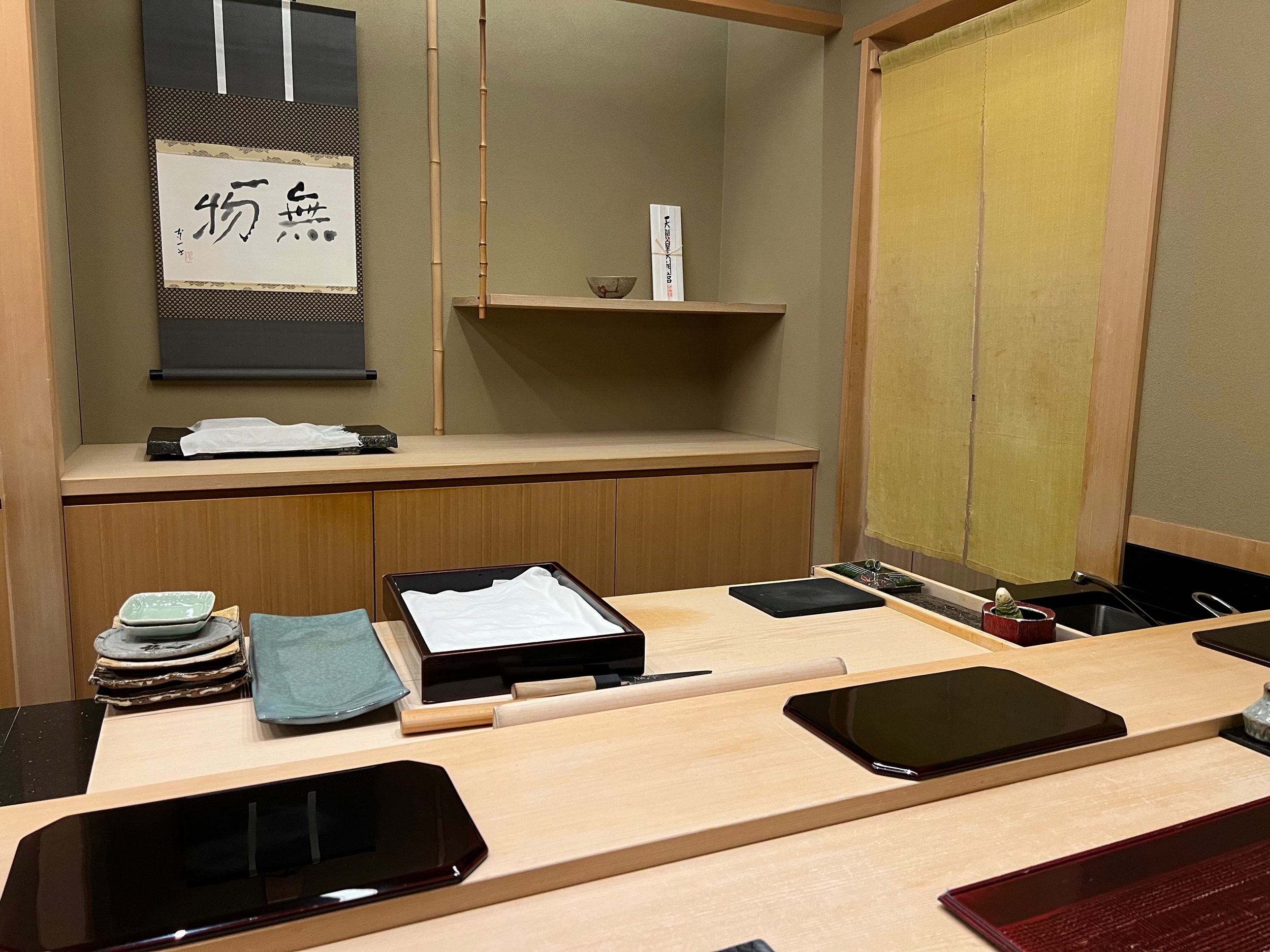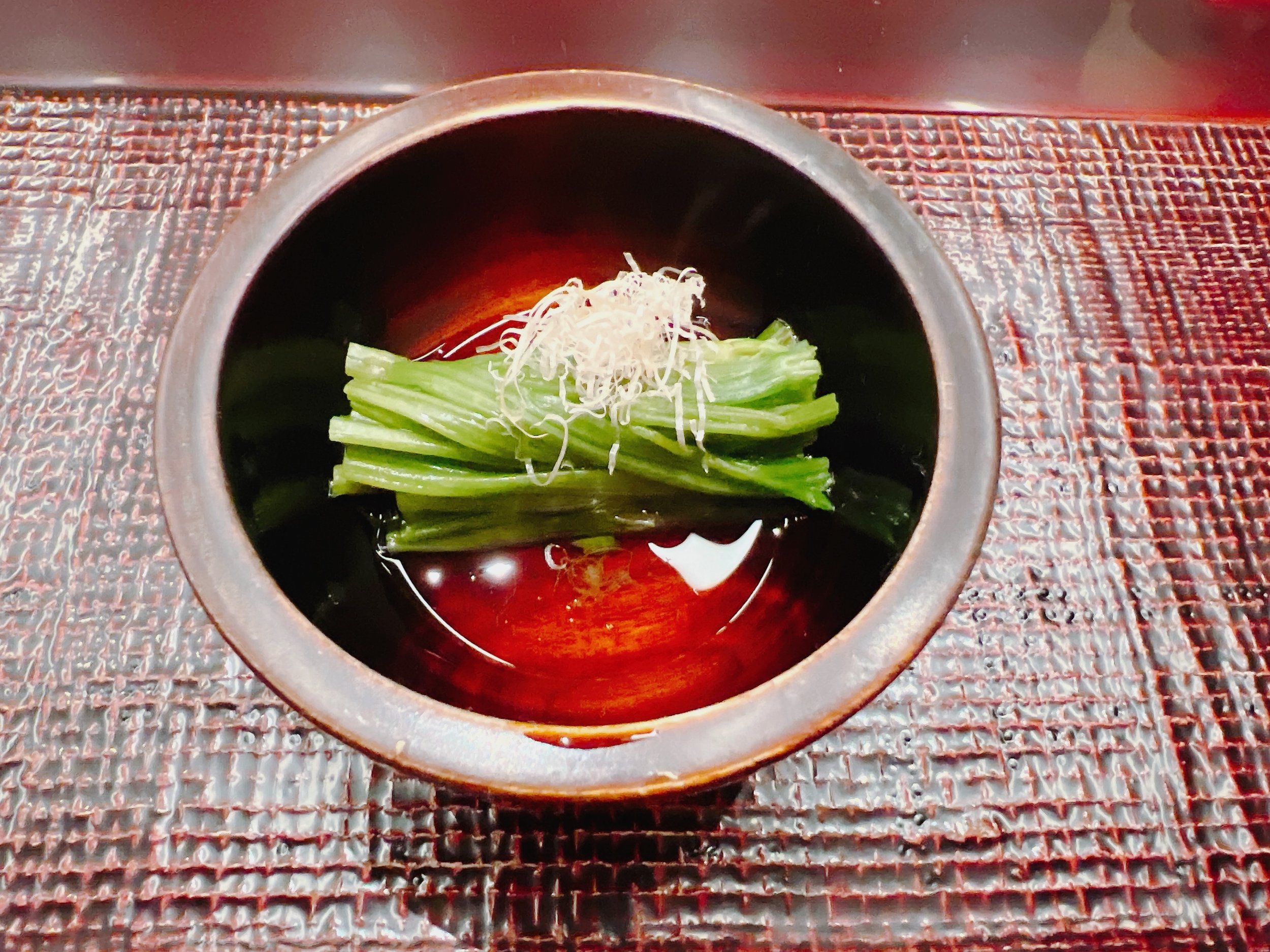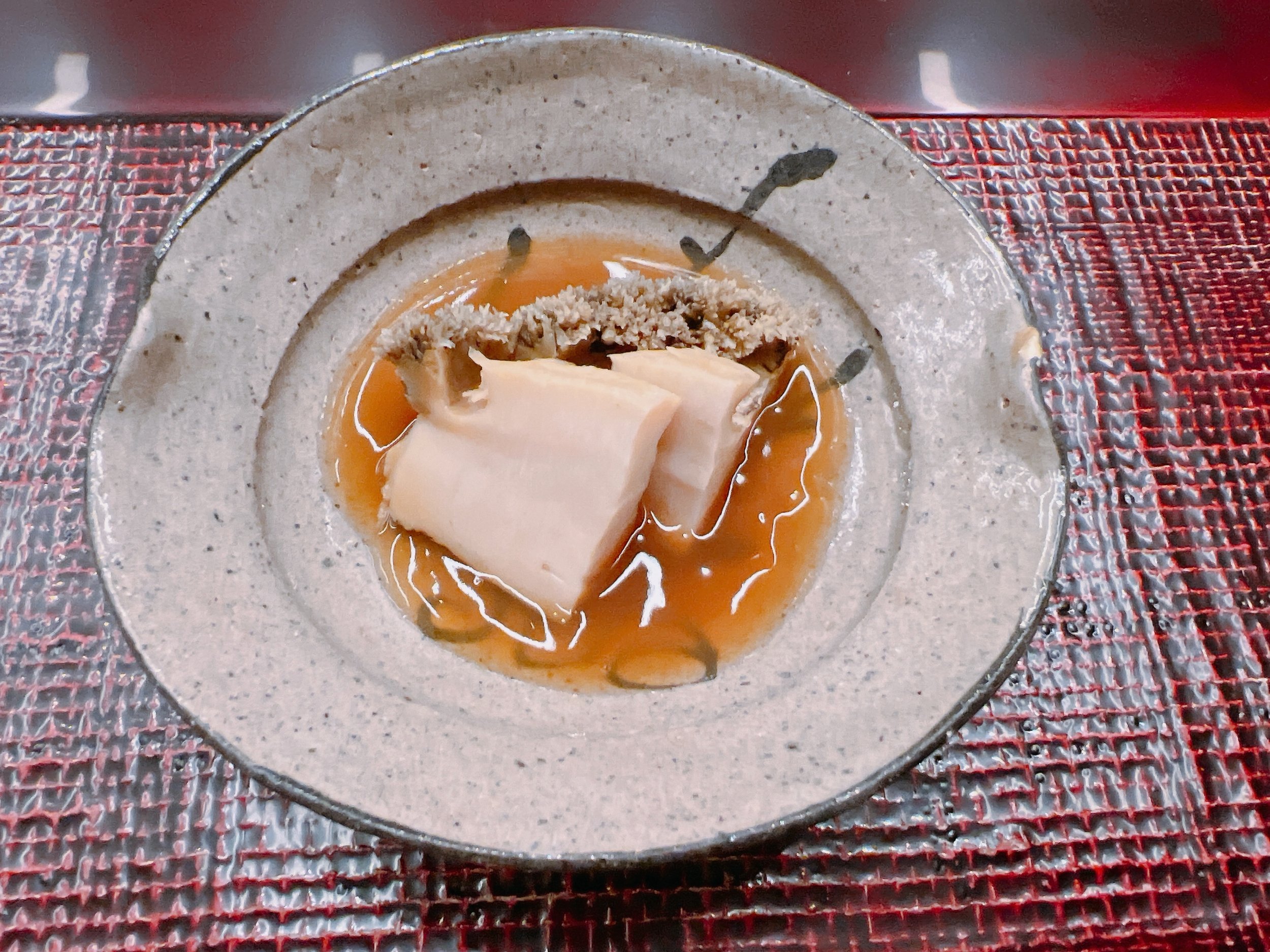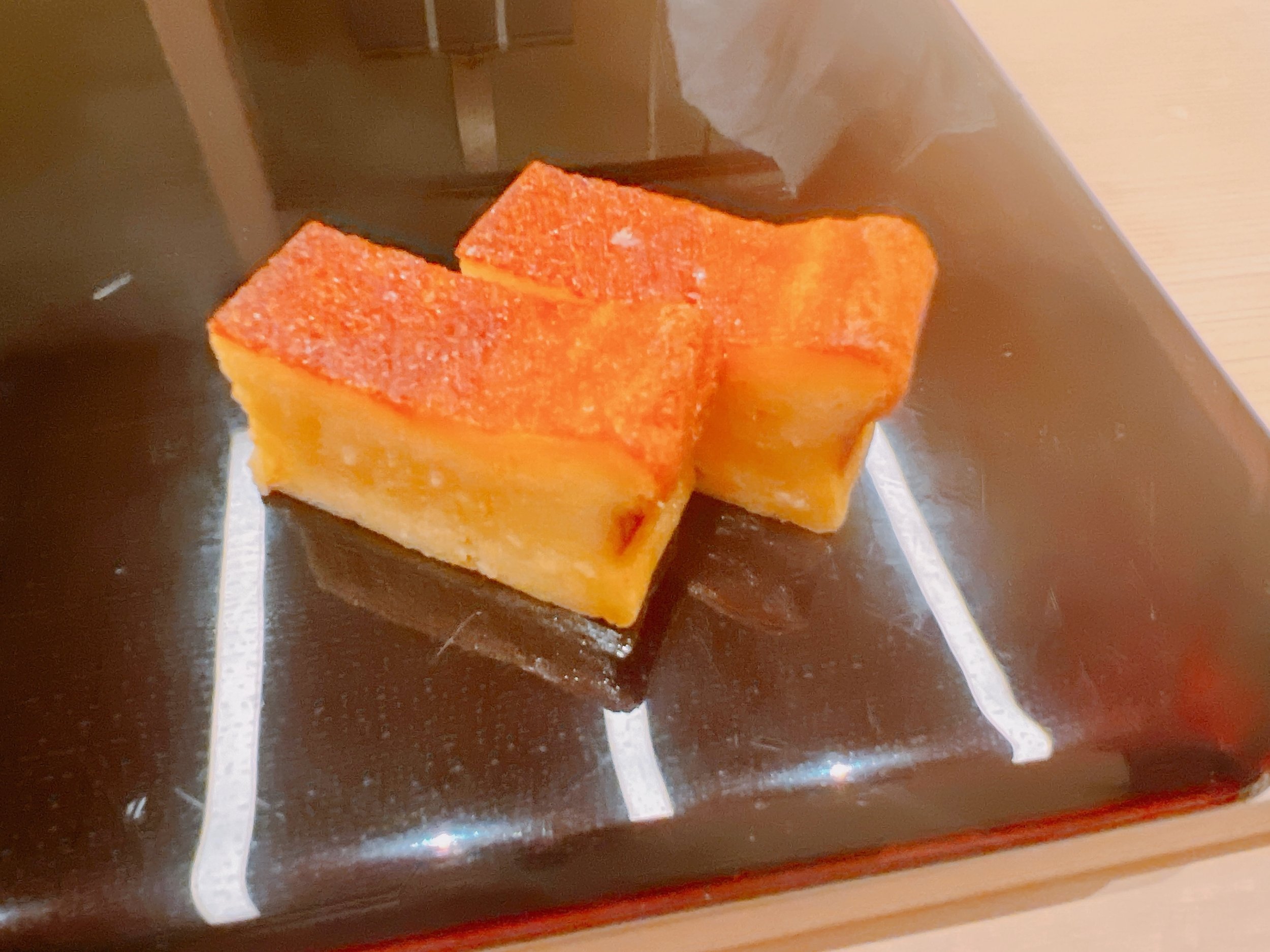Harutaka - Tokyo
Rating: 17/20
Where: Tokyo, Japan
When: Dinner for 2 on 6 March 2024
Cost per Person: Tasting menu ~50000 JPY
Accolades: 3 Michelin Stars, Tabelog Bronze Award (2024)
Why: Sushi menu with consistently great nigiri
“Harutaka” is currently the only three-Michelin-starred sushi restaurant in Japan. Curiously, this exclusivity owes less to Michelin’s pickiness and more to a special situation in Japan where most sushi restaurants of this caliber are by-introduction-only and therefore off limits to the Michelin Guide. Well, luckily Harutaka (still) takes reservations from the general public, and that’s why we were ambling through Tokyo's Ginza district on a chilly evening in early March. Away from the main streets with their fancy department stores, we walked past high-rises whose sky-high illuminated signs promised a restaurant on seemingly every single floor. And indeed, on the sixth floor of one such building we finally found Harutaka. From the elevator there was a brief walk on a faux-outdoorsy stone path past the traditional curtains marking the restaurant’s entrance. Just beyond was the dining room, where an L-shaped counter seated about a dozen guests. The eponymous chef trained for over a decade under the famous Jiro, and he personally prepared all the nigiri sushi for our dinner, while his staff created the non-sushi courses. During our meal, the four non-Japanese speakers were all seated together at one end of the counter, while the chef chatted with the rest of the guests. Luckily, one of his apprentices spoke decent English and explained each course to us in detail, sometimes enlisting the help of a Japanese/English sushi handbook.
Reservations are taken about two months in advance, and were relatively easy to obtain. For variety's sake, I tried the reservation platform Tableall, which worked great, but charged a substantial reservation fee. I paid 65000 JPY per person all in, which meant that the dinner without tax, service charge or reservation fees might have been around 50000 JPY. Following the chef’s recommendation for sakes was a safe choice; two carafes of sake and two glasses of wine set us back 11000 JPY.
Dinner started with a clear broth that contained some green vegetable (possibly celery, details were lost in translation). Whatever it was, it was a bit chewy. Served at room temperature, this dish was simple but unremarkable 13.
A hot broth made from soft shell turtles was slightly better. It had a light, hard-to-place flavor, and a decent amount of salt. Pleasant enough 15.
The next dish was made from several parts of fugu (blowfish). Different cuts of the potentially lethal fish were served with its milt and topped with radish seasoned with ponzu. A bit of spicy pepper powder was provided on the side. As is pretty common, the fugu didn't taste of much and was quite chewy - not exactly a winning combination in my book. In the end, this dish tasted mostly of the shredded radish drenched in ponzu (and/or the pepper powder if desired). I've had very few exciting fugu dishes in my life, and this was not one of them 15.
Sashimi time! We received two pieces each of flounder (hirame) and cockle (torigai). The flounder was characteristically chewy (although one of my pieces wasn't too bad); other than that, it had a slightly meaty texture and a light flavor - quite good. The cockle was tender with a light bite, had a meaty consistency and an elegant flavor - very nice 17.
Two surprisingly large pieces of steamed abalone arrived next. They came from a fresh abalone, tender but with lots of bite - chewing this required a considerable amount of work. The accompanying sauce was a good complement, reminiscent of the customary abalone liver sauce, but much, much lighter 17.
More good things came in twos: two pieces of smoked Spanish mackerel (sawada) were served with garlic flavored leeks. The mackerel's smoky flavor was both pronounced and lovely - a perfect match for the fatty fish. The quite salty leeks were a nice addition 18.
Next: an (at least to me) unusual preparation of firefly squid (hotaru-ika). The squid had been pureed, leading to a moussey consistency, and topped by a tiny bit of spicy Japanese mustard. The mousse was quite aromatic, with a hint of squid flavor. I'm not quite sure why we didn’t receive the whole squid. Also, this mousse would have been wonderful on a cracker 15.
A small piece of swordfish, served hot, was delicious. Full of flavor, fatty, and lightened up some radish on the side. Very nice, this was one of my favorite appetizers 18.
At this point we came to the “main” attraction of our dinner: the nigiri sushi. In the spirit of full disclosure, I tend to prefer bolder flavors among sushi, so view the following ratings through that lens. Apologies also for the reflections in the following photos - Harutaka probably doesn't (need to) cater to the Instagram crowd.
To start, we got a nigiri of cuttlefish (sumika). It was lightly creamy in texture, and had a noticeable bite without being rubbery or chewy - very nice. The sushi rice was on the vinegary/acidic side, which actually went well with the seafood 17.
Next, Japanese halfbeak (sayori) displayed a more neutral flavor, but had a solid texture. Nice 18.
A very classical progression of three kinds of tuna followed. First, the leanest cut, maguru akami. Having been marinated, it had a good flavor, and was definitely lean 17. Chutoro, also marinated, was noticeably more fatty, almost melting in one's mouth but also exhibiting tons of flavor. The high point of the meal for me 19. Finally, otoro, the fattiest part of the tuna belly, was lovely as well, but its considerable fattiness made it feel a bit less elegant than the preceding chutoro 18.
Gizzard shad (kohada) tasted quite fishy (in a good way), similar to mackerel (saba), and had a clean flavor 17.
The following surf clam (kobashira) almost looked like a scallop. Chopped up and marinated, it was served on top of warm sushi rice, which did wonders for bringing out the clam's flavor. The clam had a nicely meaty texture, and there was a hint of spiciness 18.
Tiger prawns (kurumaebi) had been cooked out of sight in the kitchen, but were peeled in front of us. Tender and nicely prepared, they had a bit of (but not too much) sweetness - a really nice example of prawns (ebi). The wasabi was quite noticeable here, doing a good job at countering the prawns' sweetness 17.
Amberjack (buri) was extremely fatty - feeling closer to otoro than to hamachi. It melted in one's mouth, and there was a noticeable saltiness to it 18.
An orient clam (hamaguri) was seasoned with a sweet soy sauce. The clam's texture was - as expected - a bit chewy, and the sauce added some sweetness. Quite nice 18.
Sea urchin (uni) from Hokkaido was salty, creamy, lightly sweet and overall very good 18.
Hurtling toward the finish line, we were served sea eel (anago). This was the lightest anago meat I've ever had - airy and tender, fresh and lightly brushed with a sauce that was full of flavor. Excellent 18.
We declined the offer of even more sushi at this point, since we were already quite full. Our meal ended the traditional way: a piece of tamago, accompanied by a cup of hot green tea. This bite of egg omelet was (as expected) eggy and very sweet. Generally, this is not one of my favorite courses, occupying a no man's land between savory and sweet. But Harutaka's version was actually quite good, noticeably leaning towards being a proper dessert 17.
Overall: A sushi dinner that was considerably better than what one usually gets in Tokyo (or the world). The standouts were the consistently excellent nigiri. Unfortunately, the appetizers were a bit more on the hit and miss side, but still included some very nice dishes. Together with the relaxed and friendly service, this all made for an enjoyable dinner. That said, without any true standout dishes, the three-star rating (and corresponding price tag) felt like a bit of a stretch 17.





















